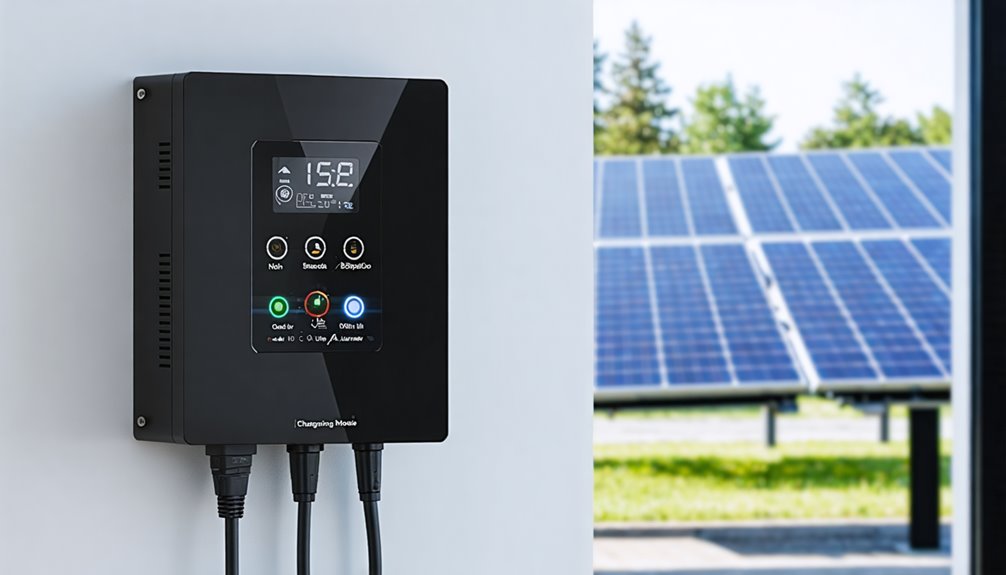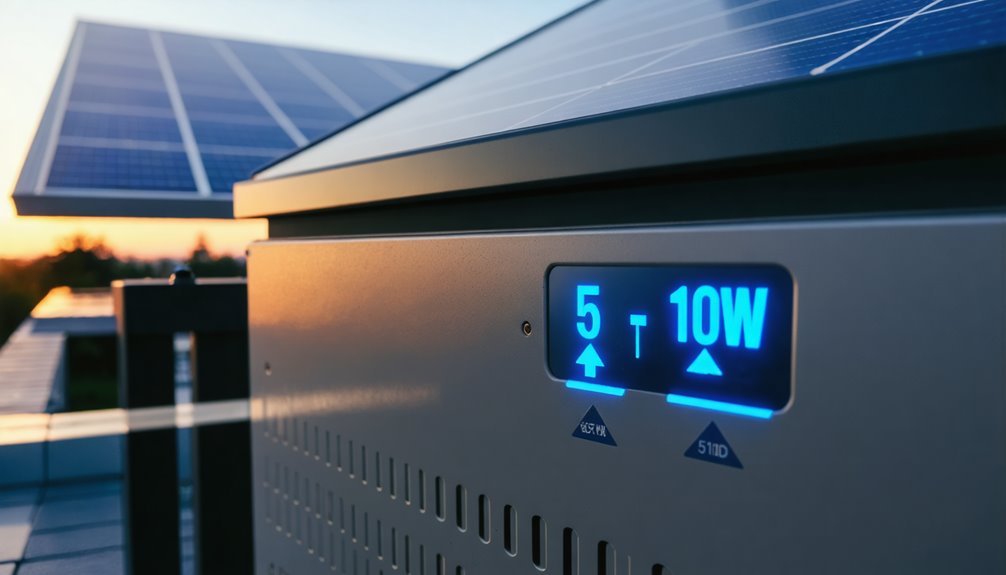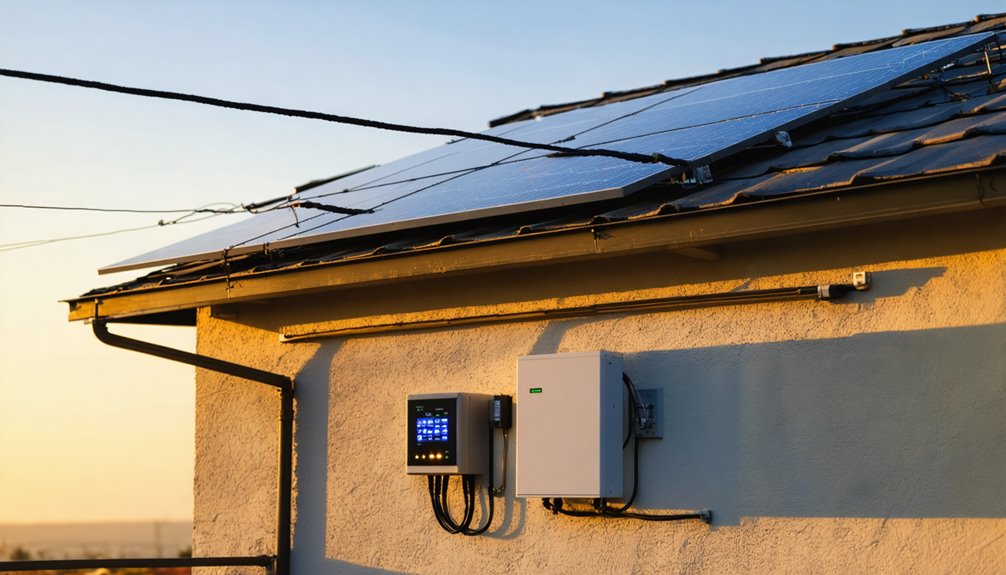You’ve noticed your solar battery pulling power from the grid when it should be using free sunshine. This puzzling behavior happens more often than you’d think. Your smart battery system makes split-second decisions based on weather, time of day, and your home’s energy needs. Sometimes it even charges from the grid on purpose to save you money. Understanding why this happens can help you maximize your solar investment.
How Solar Battery Systems Decide Between Solar and Grid Charging
How does your solar battery know when to switch from solar to grid power? Your system’s intelligent management technology makes this decision automatically. It constantly monitors three key factors: your home’s energy needs, the battery’s current charge level, and how much power your solar panels are producing. When sunlight’s limited or your panels can’t generate enough electricity, the system detects this shortage. It’ll then start using grid power to charge your solar battery. This guarantees you’ve got backup power ready when you need it. The management system also checks if your battery’s getting too low. If stored energy drops below safe levels, it’ll switch to grid charging. This prevents your battery from running completely empty and protects it from damage. This automatic switching ensures energy independence by making the most efficient use of both solar energy and the grid to keep your power supply reliable.
Common Reasons Your Battery Charges From the Grid
Your solar battery might pull power from the grid for several practical reasons. When clouds block the sun or night falls, your panels can’t generate enough energy to charge the battery, so it’ll use grid electricity instead. The system might also charge from the grid during off-peak hours when electricity rates drop, helping you save money on your power bills. Additionally, a solar battery charge controller ensures that excess solar energy is managed efficiently, protecting the battery from overcharging and optimizing system performance.
Insufficient Solar Generation
Cloudy skies can turn a solar battery’s charging habits upside down. When clouds block the sun, your panels can’t generate enough electricity. This insufficient solar generation forces your battery to pull power from the grid instead.
You’ll notice this problem during winter months too. Shorter days mean fewer hours of sunlight hitting your panels. Your battery needs consistent power to stay charged, but the panels can’t deliver enough.
Weather isn’t the only culprit. If you’re running multiple appliances or high-powered devices, your solar panels might not keep up. Your home’s energy demands can exceed what the panels produce. When this happens, battery charging shifts to grid power automatically. The system prioritizes keeping your lights on and appliances running over storing solar energy.
Time-Based Rate Optimization
Most solar battery owners don’t realize their system’s charging from the grid on purpose. Your smart battery charges from the grid during off-peak hours when electricity rates drop markedly. This automatic feature saves you money.
Modern solar batteries use advanced technology to detect lower rates. When prices fall at night, your system switches to grid power for charging the battery. You’ll pay less for the same amount of stored energy.
Some utility companies even reward customers who charge during these times. They offer special rates to encourage off-peak usage. This helps balance the electrical grid while reducing your costs.
Your battery charges strategically, storing cheaper electricity for later use. When peak rates hit, you’ll use this stored power instead of expensive grid electricity.
Understanding Ac-Coupled Vs Dc-Coupled Battery Systems
How do AC-coupled and DC-coupled battery systems differ? Your AC-coupled battery connects to your home’s AC electrical system. This means you don’t need to rewire your existing solar setup. You can easily add battery storage to your current solar panels.
DC-coupled batteries connect directly to your solar panels on the DC side. They’re slightly more efficient because they don’t convert power as often.
Here’s the key difference: You can charge your AC-coupled battery from the grid. This lets you charge during cheaper, off-peak hours. DC-coupled systems typically can’t do this.
DC-coupled systems might cost less upfront. But if you’ve already got solar panels, AC-coupled systems let you add storage without replacing your equipment. That’s why they’re becoming more popular with homeowners.
Additionally, investing in a solar battery can be influenced by factors such as local electricity rates, which can affect your return on investment timeline.
Grid Charging During Off-Peak Hours for Cost Savings
Your battery doesn’t just charge from solar panels. Solar batteries can pull power from the grid during off-peak hours when electricity rates drop. You’ll save money by charging at night when rates are lowest.
Many battery systems have smart controls that automatically switch to grid charging at the cheapest times. This means you won’t need as many solar panels, cutting installation costs.
| Time Period | Rate Type | Cost per kWh |
|---|---|---|
| 12am-6am | Off-Peak | $0.08 |
| 6am-9am | Peak | $0.24 |
| 9am-5pm | Mid-Peak | $0.15 |
| 5pm-12am | Peak | $0.24 |
Your battery stores cheap overnight electricity. Then you’ll use it during expensive peak hours. Modern systems track energy prices and charge when it’s most cost-effective for you.
When Solar Production Falls Short of Energy Demands

When clouds block the sun or night falls, solar panels can’t produce enough electricity to power a home. Your battery system then kicks in to fill the gap. But what happens when you’re using more energy than your panels make?
Your solar setup can’t always store excess solar energy for every situation. If you’re running multiple appliances while your panels aren’t producing much power, the battery alone won’t meet your needs. That’s when it pulls electricity from the grid.
This happens most during extended cloudy periods or when you’re using high-energy devices. Your inverter automatically decides when grid charging is necessary. It’s designed to keep your lights on and appliances running, even when solar production drops below what you need. In such cases, the battery capacity plays a crucial role in determining how long your solar battery can sustain household energy needs without grid support.
Smart Battery Management Systems and Automatic Switching
Modern solar batteries don’t just store energy—they’re equipped with smart management systems that decide when to use solar power and when to tap into the grid. These intelligent systems use sensors that track your solar and battery levels constantly. They monitor how much energy you’re producing and using. When your solar panels can’t keep up with demand, the system automatically switches to grid power. You won’t need to flip any switches or press buttons. It all happens seamlessly. Popular batteries like Tesla Powerwall and Enphase IQ include special features. Storm Watch prepares for outages, while Load Controller manages when to store solar energy. These systems also charge from the grid during off-peak hours when electricity costs less. This automatic switching saves you money while keeping your home powered efficiently. Furthermore, off-grid locations can also benefit from these solar batteries by providing reliable energy access when grid connectivity is unavailable.
Weather-Related Grid Charging Features and Storm Protection
Your solar battery might start charging from the grid when severe weather’s approaching, thanks to features like Storm Watch and Storm Guard. These systems automatically detect weather alerts and switch to grid charging before storms hit, making sure you’ll have backup power if the electricity goes out. The battery fills up from the grid while it’s still available, so you won’t lose power to your essential appliances even if your solar panels can’t produce energy during the storm.
Storm Watch Activation
Before a major storm hits, your solar battery might start charging from the grid automatically. This happens through storm watch activation, a smart feature in batteries like Tesla Powerwall and Enphase IQ.
Your battery’s system constantly monitors weather forecasts. When it detects severe weather approaching, it switches to grid charging mode. This guarantees your battery is charged to full capacity before potential power outages occur.
The technology works like an early warning system. It doesn’t wait for the storm to arrive. Instead, it prepares in advance by pulling electricity from the grid while it’s still available. This way, you’ll have backup power ready when you need it most.
Different manufacturers call this feature by different names, but they all serve the same purpose: keeping your home powered during emergencies.
Pre-Outage Battery Preparation
Storm watch activation is just one part of how batteries prepare for outages. Your solar battery uses pre-outage battery preparation to get ready before severe weather hits. Smart sensors detect when storms approach. They automatically start charging from the grid without you doing anything.
This charging happens even if you already store solar energy from earlier. Your battery wants to be completely full when the power goes out. Auto-transfer switches make this process smooth and fast.
These features give you peace of mind during bad weather. You don’t need to worry about checking battery levels or flipping switches. The system handles everything itself. Your battery fills up with power before the storm arrives, keeping your lights on when the grid fails.
Weather Alert Integration
When weather alerts signal approaching storms, solar batteries connect with local weather services to start charging from the grid automatically. Your system’s smart sensors detect severe weather warnings and switch from solar energy to grid power. This guarantees you’ll have backup electricity when storms hit.
| Feature | Brand | Function |
|---|---|---|
| Storm Watch | Tesla | Pre-charges battery before storms |
| Storm Guard | Enphase | Activates grid charging automatically |
| Weather Integration | Both | Connects to local weather services |
| Alert Response | Both | Switches within minutes of warnings |
| Power Priority | Both | Grid charging over solar during storms |
These weather alert systems work 24/7. They monitor forecasts and prepare your battery without any action from you. During severe weather, they’ll maximize grid charging when solar panels can’t produce enough energy due to cloud cover.
The Role of Inverter Settings in Grid Charging Behavior

Your inverter’s settings play a major role in whether your solar battery charges from the grid. These devices have options that let you set charging preferences. Many users don’t realize their inverter might be programmed to pull power from the grid when solar production drops.
Some inverters prioritize grid stability over battery usage. They’ll draw grid power to meet immediate needs, even if your battery has stored energy available. This happens because of how the system’s configured.
Regular monitoring reveals if your inverter settings favor grid charging unnecessarily. These configurations can be adjusted to change your battery’s charging behavior. When properly set, inverters can maximize stored solar energy use and reduce grid dependency.
Benefits of Maintaining Grid Connection for Battery Systems
You’ll find that keeping your solar battery connected to the grid offers several important advantages for your home energy system. Your battery can maintain backup power security during emergencies, help you save money through smart cost optimization strategies, and provide greater system flexibility for managing your daily energy needs. These benefits explain why many solar battery systems are designed to work alongside the grid rather than completely independently. Additionally, by maintaining a grid connection, your solar system can take advantage of time-of-use optimization to effectively manage energy costs and storage efficiency.
Backup Power Security
Even though solar panels generate clean energy, maintaining a grid connection provides essential backup power security for battery systems. You’ll find that grid connectivity guarantees your batteries stay charged when you need them most.
Your backup power security improves markedly when you can charge batteries from the grid before storms or outages hit. Weather forecasts help you prepare by charging a solar battery system in advance. This preparation means you’ll have power for critical devices like medical equipment, refrigerators, and heating systems.
Smart battery systems automatically detect when charging is needed. They’ll pull power from the grid when solar production drops. This automatic feature works without any input from you.
During extended cloudy periods, you won’t worry about running out of stored energy. Your grid connection acts as a reliable safety net.
Cost Optimization Strategies
When electricity rates drop during off-peak hours, homeowners can save significant money by charging their solar batteries from the grid. You’re fundamentally buying power when it’s cheapest and using it when prices spike. This strategy helps reduce your overall energy bills.
Your power systems can work smarter with this approach. Instead of relying only on sunshine, you’ll have flexibility in managing energy. When there’s not enough solar generation, your batteries can still get charged from the grid without any manual work.
This method also affects solar panels cost considerations. You won’t need to buy as many panels since you’re not depending entirely on solar generation. Your battery management system automatically switches between solar and grid charging based on what’s most economical at any given time.
System Flexibility Enhancement
Keeping your solar battery system connected to the grid offers more than just cost savings—it provides backup power options that pure solar systems can’t match. This system flexibility enhancement means you’ll always have power, even during cloudy weeks or emergencies.
Your modern battery switches between solar and grid power automatically. You don’t need to flip any switches or change settings. The system knows when to use grid power to keep your battery charged.
| Grid Power Benefits | What It Means |
|---|---|
| Cloudy day backup | Battery stays full |
| Emergency charging | Power’s always ready |
| Automatic switching | No manual work |
| 24/7 availability | Never run out |
During extended rainy periods, your solar panels won’t generate enough electricity. That’s when grid charging becomes essential for maintaining your home’s energy supply.
Detecting and Troubleshooting Unexpected Grid Pull
How can you tell if your solar battery’s pulling power from the grid when it shouldn’t? You’ll notice unexpected grid pull when your monitoring system shows grid usage despite having solar power available. Energy experts report that configuration issues often cause this problem. The battery works differently when the system’s settings prioritize grid charging over solar storage. Your inverter might pull grid power to maintain its heartbeat design function. This happens when it can’t meet your home’s energy demands with solar alone. Hidden loads you’re not aware of can also trigger grid usage. Different meters might show conflicting readings too. Your inline meter and power bill could display different numbers, making it harder to spot the actual problem. It’s important to ensure the proper wiring configurations are in place to prevent accidental grid usage and maintain optimal efficiency.
Grid Heartbeat Checks and Minimal Power Draw

Your inverter needs to check if grid power’s available, even when your solar panels produce plenty of energy. These grid heartbeat checks create a minimal power draw from your electrical network. Your system pulls tiny amounts of electricity to confirm the grid’s working properly. This safety feature guarantees your inverter keeps running smoothly. Without these checks, your system might shut down unexpectedly.
A daily minimal power draw ensures advanced technical support, maintaining efficiency in transitions between solar, battery, and grid power, which are common in hybrid inverter systems.
| Power Draw Type | Typical Usage |
|---|---|
| Heartbeat checks | 0.01-0.04 kWh |
| Daily grid pull | About 0.5 kWh |
| Large appliance support | Varies by load |
| Safety monitoring | Continuous small draw |
Your inverter’s minimal power draw costs very little compared to keeping your solar system stable. These small amounts help maintain operational safety and prevent system failures during power outages.
Optimizing Your System Settings to Control Grid Charging
When you adjust your inverter settings, you’ll gain better control over how your solar battery charges from the grid. These settings let you prioritize battery charging over sending power back to the grid.
Your energy management system‘s interface shows configuration options for ideal battery charging based on your home’s energy patterns. Battery management systems track when and why grid charging happens. This data helps you make informed changes to your settings.
Modern batteries include features that distribute energy based on what’s available. Some systems can stop grid charging when your solar panels produce enough power. You’ll find these options in your system’s settings menu.
Government rules and incentives affect how you can configure grid feeding. Understanding these regulations helps you set up your system to use more solar power and less grid energy.
To properly optimize your setup, consider the charge controller types and sizing calculations as they play a crucial role in the efficiency of your solar power system.
Conclusion
Your solar battery’s grid charging isn’t a malfunction. It’s working as designed. The system pulls power from the grid when solar panels can’t produce enough energy or when electricity rates are cheapest. This smart technology keeps your home powered while protecting your battery from damage. Whether it’s cloudy weather, nighttime, or high energy use, your system automatically switches between solar and grid power to meet your needs efficiently.


